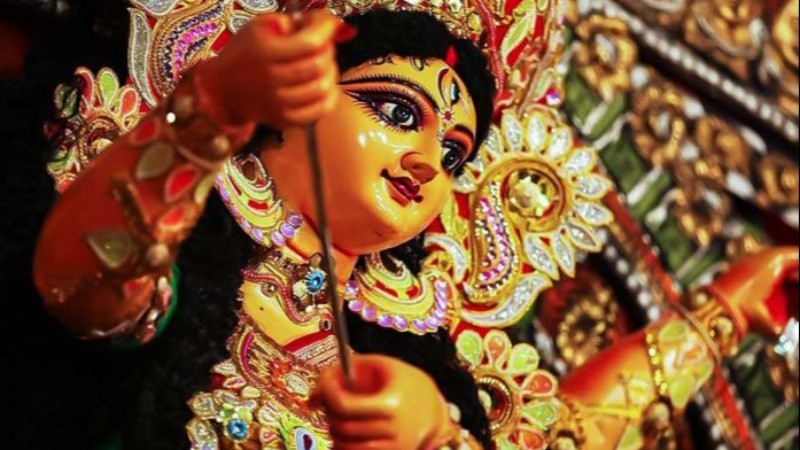
Across the country, Navratri is celebrated in diverse styles for nine days, dedicated to the worship of Goddess Durga. During this auspicious time, her nine forms are revered through various rituals and prayers. This festival is steeped in numerous beliefs and traditions that have been passed down through generations, holding a special place in Hinduism. Goddess Durga embodies divine strength and is known for vanquishing evil. Her stories, from her birth to her majestic lion as her vehicle, to the significance of the Kanya Puja and the tale of Mahishasura's defeat, are familiar to many. However, the deeper facts and traditions surrounding these beliefs are often overlooked. Here, we explore nine intriguing aspects of Goddess Durga that are celebrated during Navratri.
1. The Birth of the Goddess
According to ancient scriptures, when the demon Mahishasura defeated the gods and seized control of the heavens, the deities convened and sought help from the Trimurti—Brahma, Vishnu, and Shiva. In response, these three gods combined their energies to create a powerful being. This is how Goddess Durga was born. Each deity bestowed a unique power upon her: Shiva gave her his trident, Vishnu his discus, Brahma his lotus, the Wind God granted her a nose, and the Mountain God (Himalayas) provided her clothing, bow, and lion. This is why Durga is often regarded as the embodiment of strength, making her the most powerful goddess in the Hindu pantheon.
2. The Eight Arms of the Goddess
Goddess Durga is typically depicted with eight arms, although some scriptures mention ten arms. In Vastu Shastra, eight directions are deemed significant, while some texts refer to ten cardinal directions. These directions include:
Prachi (East)
Prateechi (West)
Uddichi (North)
Avachi (South)
Ishaan (North-East)
Agniya (South-East)
Nairitya (South-West)
Vayu (North-West)
Urdhva (Towards the sky)
Adharasta (Towards the underworld)
Each of these arms symbolizes the goddess’s ability to protect her devotees from harm from all directions, reflecting her omnipresence.
3. The Nine Days of Worship
The nine days of Navratri commemorate the battle between Goddess Durga and Mahishasura, which lasted for nine days. Each day symbolizes a different aspect of the goddess. According to tradition, during this battle, Goddess Durga took on various forms to defeat the demon on each day, hence the celebration of her nine distinct forms during Navratri. This time is marked by rituals, prayers, and fasting, culminating in the celebration of her victory.
4. The Significance of the Lion
Goddess Durga rides a lion, a symbol of power and strength. It is believed that when the goddess sets out to eradicate pain and evil, she travels on this mighty animal. The lion represents courage and the ability to conquer fear, which is essential for her divine mission of restoring balance and justice in the universe.
5. The Three Eyes of the Goddess
Goddess Durga is often referred to as "Trayambake," meaning "the one with three eyes." This is significant as Lord Shiva, too, is known for having three eyes. Durga’s three eyes represent the Sun, the Moon, and Fire, symbolizing her ability to see beyond the mundane, recognizing good and evil. They also signify the transcendence of time, encompassing the past, present, and future.
6. The Chanting of 108 Mantras
It is believed that Lord Rama worshipped Goddess Durga before heading to Lanka, addressing her as Mahishasura Mardini. This worship occurred before his battle with Ravana, and on the tenth day, Ravana was slain, marking the festival of Dussehra, which coincides with the conclusion of Navratri. As part of his prayers, Rama offered 108 blue lotuses to the goddess, establishing the tradition of chanting 108 mantras during the festival, which is considered to bring good fortune and blessings.
7. The Timing of Navratri After Pitra Paksha
Pitra Paksha is the period dedicated to honoring deceased ancestors, and it is believed that after this period, the home is purified. Consequently, the festival of Navratri follows Pitra Paksha, marking the beginning of the "Devi Paksha" or the goddess's time. This transition is significant as it heralds the start of the festive season, culminating in various celebrations and religious observances.
8. The Sacred Soil from the Courtyard of a Tawaif
A unique belief associated with the festival is regarding the sacredness of the soil from the courtyard of a tawaif (courtesan). It is said that a man leaves all his purity behind when entering her premises. Therefore, this soil is considered sacred and is mixed to create idols of Goddess Durga. This custom reflects the importance of purity and sanctity in rituals.
9. The Importance of Kanya Puja
Before the onset of menstruation, young girls are considered embodiments of the goddess, symbolizing purity. During the festival, especially on the eighth (Ashtami) and ninth (Navami) days, it is customary to invite young girls for a ceremonial meal, offer them gifts, and seek their blessings. This tradition is believed to have been popularized by Swami Vivekananda in 1901 at the Belur Math, emphasizing the significance of honoring the feminine aspect of divinity.
Navratri is not just a festival; it is a profound expression of faith, reverence, and the celebration of feminine power. Each of these traditions and beliefs contributes to the rich tapestry of the festival, reinforcing the values of strength, protection, and devotion. As we celebrate Navratri, we pay homage to Goddess Durga and acknowledge her vital role in the cosmic order.
Make This Havan Cup During Navratri to Remove Negativity from Your Home
Rahul Gandhi Defends Comments in US, Blames BJP for Lies and Desperation
Tirupati Laddu LIVE: Temple Trust Claims Purity Amid Adulteration Allegations